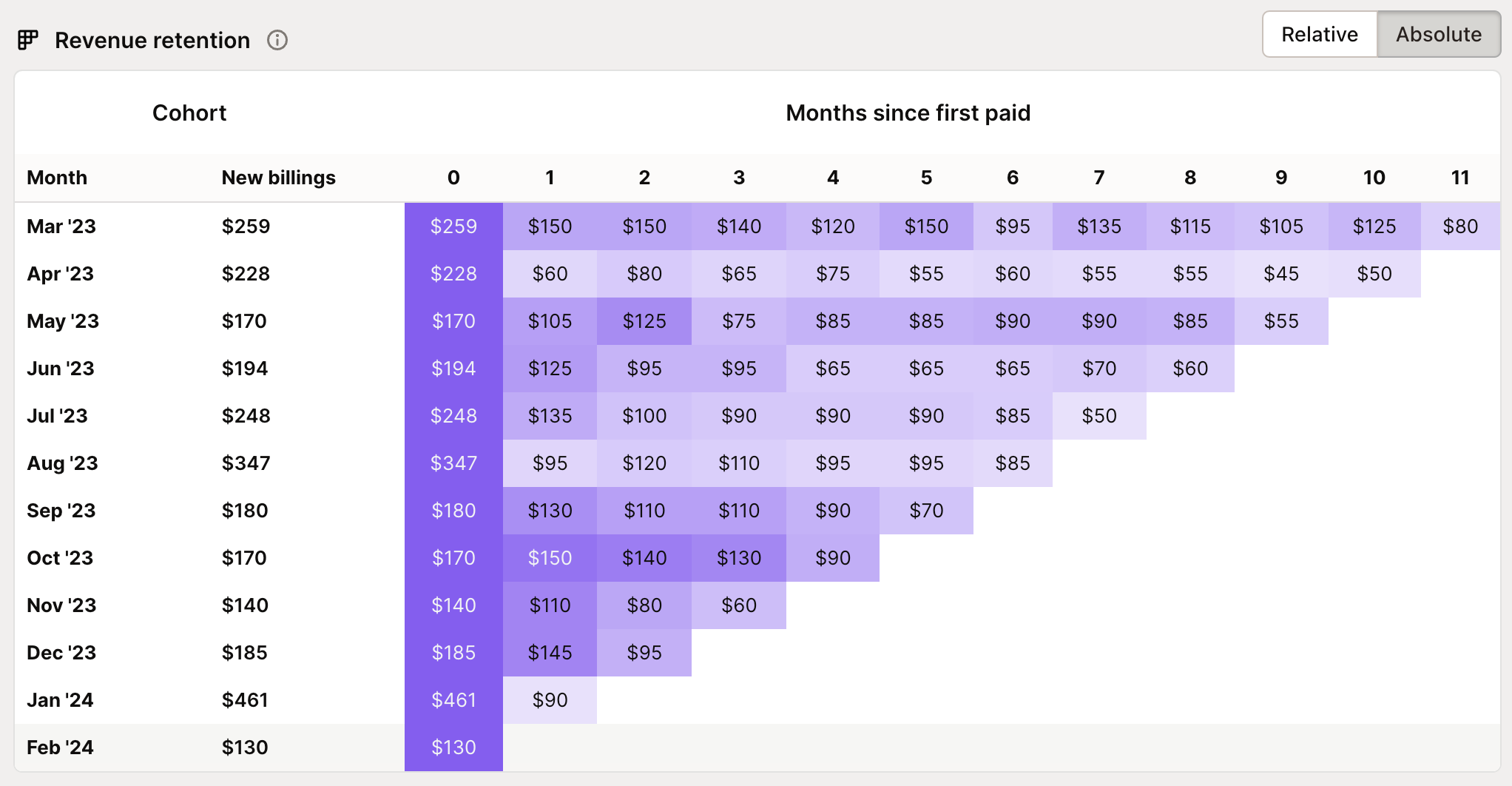Revenue retention cohorts
Getting customers is one thing - keeping their revenue is another. Revenue Retention Cohorts shows you exactly how much value you retain from each group of customers over time, helping you spot patterns in both revenue stability and growth opportunities. This goes beyond simple customer counts to show you the true financial impact of your retention efforts.
What makes this report different
Most retention metrics focus on how many customers stick around. The Retention Cohorts report takes it further by tracking the actual money retained from each group of paying customers over time. Even better, it can show retention rates above 100% when customers grow their usage or upgrade their plans - giving you clear signals about which cohorts are your best opportunities for expansion.
Report components
The revenue picture

The main visualization breaks down your revenue retention by customer cohort:
- New billings: Shows the initial revenue from each monthly cohort of new paying customers. This is your baseline for measuring future retention.
- Monthly tracking: See exactly what percentage of that initial revenue stays (or grows) month after month.
- Complete timeline: Track retention from month 1 all the way through month 12, revealing both short-term and long-term patterns in customer value.
Two powerful views
Toggle between two perspectives to understand your retention story:
- Relative view: Shows percentages of initial revenue retained, making it easy to compare cohort performance regardless of size.
- Absolute view: Displays actual dollar amounts, helping you understand the real financial impact of retention patterns.
Understanding your numbers
Timing and tracking
The report builds cohorts based on when customers make their first payment, not when they install or start trials. This means:
- Cohorts reflect real revenue generation, not just engagement
- First payments might represent partial months due to Shopify billing cycles
- Month 1 shows the first full month of revenue, which can sometimes exceed the initial amount
- Each subsequent month tracks revenue relative to the starting point
Reading the patterns
Your retention data tells multiple stories:
- Growth signals
- Retention rates above 100% show cohorts generating more revenue than they started with
- Usually indicates successful upgrades or increased usage
- Points to opportunities for expanding similar customer segments
- Stability indicators
- Steady retention rates across multiple months suggest stable, predictable revenue
- Helps identify which types of customers tend to maintain their value longest
- Reveals seasonal patterns that affect revenue stability
- Warning signs
- Sharp drops in retention might signal product issues or competitive pressures
- Gradual declines could suggest pricing misalignment or feature gaps
- Patterns affecting specific cohorts help isolate potential problems
- Recovery patterns
- Upward movements in later months often indicate successful reactivations
- Can show the impact of win-back campaigns or seasonal returns
- Help measure the effectiveness of customer recovery efforts
Making the most of this report
Smart analysis
Get more value from your retention data:
- Compare cohort performance
- Look for months or seasons that produce stronger retention
- Identify acquisition channels that bring more stable revenue
- Track how product changes affect newer cohorts
- Investigate patterns
- Dig into cohorts with unusually high or low retention
- Look for common characteristics in stable cohorts
- Connect retention changes to specific business initiatives
- Plan for growth
- Use historical patterns to forecast revenue stability
- Identify optimal times for expansion initiatives
- Guide customer success efforts toward proven retention patterns
Pro tips
Level up your retention analysis:
- Smart filtering
- Use segments to analyze retention across different customer types
- Compare retention between billing providers if you use multiple systems
- Focus on specific time periods to measure initiative impact
- Pattern recognition
- Watch how newer cohorts perform compared to historical patterns
- Track the impact of product changes on retention curves
- Use absolute numbers to weigh the importance of percentage changes
- Action planning
- Focus expansion efforts on cohorts showing growth potential
- Plan interventions before historical drop-off points
- Time retention initiatives around seasonal patterns
Remember: Revenue retention tells you more than just whether customers stay - it shows you how their value evolves over time. Use these insights to focus your retention efforts where they’ll have the biggest financial impact.
Need help making sense of your retention patterns or building strategies for revenue growth? Our team is here to help you turn these insights into action.
Frequently asked questions
How are cohorts defined in this report?
Cohorts are built based on when customers make their first payment, not when they install or start trials. This means cohorts reflect real revenue generation, with Month 1 showing the first full month of revenue after the initial payment.
What's the difference between relative and absolute views?
• Relative view: Shows percentages of initial revenue retained, making it easy to compare cohort performance regardless of size
• Absolute view: Displays actual dollar amounts, helping you understand the real financial impact of retention patterns
What do the colors in the cohort table mean?
The colors represent retention performance - darker colors indicate higher retention rates. Values above 100% (showing growth) appear with enhanced coloring, while lower retention rates have lighter colors. This helps you quickly spot strong and weak performing cohorts.
Can revenue retention be greater than 100%?
Yes! Retention rates above 100% show cohorts generating more revenue than they started with, usually indicating successful upgrades or increased usage. This points to opportunities for expanding similar customer segments.
How do I interpret empty cells in the cohort table?
Empty cells typically indicate that the cohort hasn't reached that month yet, or there's insufficient data for that period. The system uses the last available value for missing data points to maintain continuity in the analysis.